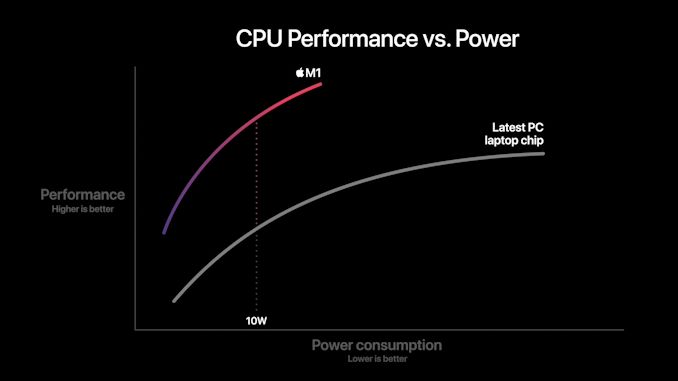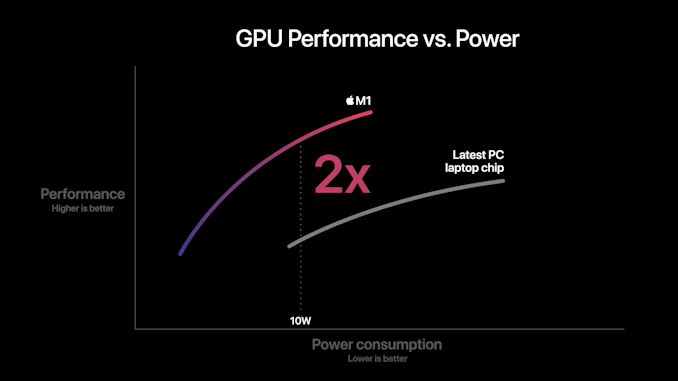Apple Announces The Apple Silicon M1: Ditching x86 - What to Expect, Based on A14
by Andrei Frumusanu on November 10, 2020 3:00 PM EST- Posted in
- Apple
- Apple A14
- Apple Silicon
- Apple M1
Apple Shooting for the Stars: x86 Incumbents Beware
The previous pages were written ahead of Apple officially announcing the new M1 chip. We already saw the A14 performing outstandingly and outperforming the best that Intel has to offer. The new M1 should perform notably above that.
We come back to a few of Apple’s slides during the presentations as to what to expect in terms of performance and efficiency. Particularly the performance/power curves are the most detail that Apple is sharing at this moment in time:
In this graphic, Apple showcases the new M1 chip featuring a CPU power consumption peak of around 18W. The competing PC laptop chip here is peaking at the 35-40W range so certainly these are not single-threaded performance figures, but rather whole-chip multi-threaded performance. We don’t know if this is comparing M1 to an AMD Renoir chip or an Intel ICL or TGL chip, but in both cases the same general verdict applies:
Apple’s usage of a significantly more advanced microarchitecture that offers significant IPC, enabling high performance at low core clocks, allows for significant power efficiency gains versus the incumbent x86 players. The graphic shows that at peak-to-peak, M1 offers around a 40% performance uplift compared to the existing competitive offering, all whilst doing it at 40% of the power consumption.
Apple’s comparison of random performance points is to be criticised, however the 10W measurement point where Apple claims 2.5x the performance does make some sense, as this is the nominal TDP of the chips used in the Intel-based MacBook Air. Again, it’s thanks to the power efficiency characteristics that Apple has been able to achieve in the mobile space that the M1 is promised to showcase such large gains – it certainly matches our A14 data.
Don't forget about the GPU
Today we mostly covered the CPU side of things as that’s where the unprecedented industry shift is happening. However, we shouldn’t forget about the GPU, as the new M1 represents Apple’s first-time introduction of their custom designs into the Mac space.
Apple’s performance and power efficiency claims here are really lacking context as we have no idea what their comparison point is. I won’t try to theorise here as there’s just too many variables at play, and we don’t know enough details.
What we do know is that in the mobile space, Apple is absolutely leading the pack in terms of performance and power efficiency. The last time we tested the A12Z the design was more than able to compete and beat integrated graphics designs. But since then we’ve seen more significant jumps from both AMD and Intel.
Performance Leadership?
Apple claims the M1 to be the fastest CPU in the world. Given our data on the A14, beating all of Intel’s designs, and just falling short of AMD’s newest Zen3 chips – a higher clocked Firestorm above 3GHz, the 50% larger L2 cache, and an unleashed TDP, we can certainly believe Apple and the M1 to be able to achieve that claim.
This moment has been brewing for years now, and the new Apple Silicon is both shocking, but also very much expected. In the coming weeks we’ll be trying to get our hands on the new hardware and verify Apple’s claims.
Intel has stagnated itself out of the market, and has lost a major customer today. AMD has shown lots of progress lately, however it’ll be incredibly hard to catch up to Apple’s power efficiency. If Apple’s performance trajectory continues at this pace, the x86 performance crown might never be regained.












644 Comments
View All Comments
Spunjji - Friday, November 13, 2020 - link
@vais - Perhaps I should have clarified that my comment was indeed regarding the single-core results? But I sort-of assumed anybody reading it would have *read the article* and thus was aware of that context. 🤦♂️We won't get multi-core data until later, for sure, but your attempt to pretend that we therefore have *no idea* what's coming is mere sophistry. I'd advise you adjust your expectations accordingly, as you've already indicated a level of certainty in the outcome (mY i5 WiLl BeAt It) that you are simultaneously arguing nobody else is entitled to. That cognitive dissonance has been noted.
vais - Friday, November 13, 2020 - link
I had missed Graviton, thanks for the link!It seems very interesting and is a much more fair comparison as all 3 CPUs have similar TDPs. AMD are still some way from Zen3 based Epyc CPUs, but even if they have better performance than Graviton 2, they still could be far behind in the performance/$.
As for M1 all I'm saying is that comparing it to other laptop CPUs with similar TDP (of course higher too since it is more efficient) is one thing. But comparing it to the latest desktop CPUs is another story and reality might not reflect the synthetic benchmarks that well.
If say M2 was positioned for the Mac Pro at 50-60-70W TDP, then comparing it to 5950X would make sense and it really could have better performance - that is all.
misan - Thursday, November 12, 2020 - link
Dedicated silicon for compiling code? Or for doing scientific computation? Or for traversing linked lists? SPEC benchmark suite is extensively documented and the individual benchmark behavior is understood. This is all plain C code that targets the CPU.I understand that it might be hard to accept it, but the simple fact is that Apple has made a substantially better chip. They can do much more work per clock than anything else on general-purpose code, which allows them to be fast without needing very high clocks.
Spunjji - Thursday, November 12, 2020 - link
@Coldfriction - the "dedicated silicon" you refer to played no part in any of the tests in this article.Coldfriction - Thursday, November 12, 2020 - link
You mean all of the memory on package with the CPU doesn't make a difference? That's the "dedicated silicon" sort of thing I'm talking about. How fast was the SNES CPU was 3.58 Mhz. It took a massively more powerful intel, amd, or cyrix chip to do what the SNES could do. MASSIVELY more powerful. What Apple is doing here is making a console PC. The performance isn't all derived from their CPU cores independent of the rest of the system. Everything is tightly integrated with no flexibility on the users end. The Cell architecture boasted similar stuff back in the day. Yes, Apple has a strong ARM CPU here, but it's the tight integration that makes it so strong, not the core itself. There's a reason the memory is in the package and non-upgradable. The functions tested in this article may drastically favor the cache system of the M1, but once you go outside of that, you lose a lot.It's ALWAYS been the case that custom built systems have outperformed generic computing devices.
This article doesn't test very many things. It certainly doesn't test demanding workloads that saturate much of the systems capabilities.
I owned Amigas back in the day. I had access to a variety of computing devices. The IBM compatible PCs were the ugliest slowest machines around, but they succeeded where everyone else's prettier systems failed. Why? Compatibility and ability to swap the software and hardware from different vendors around. They became cheap and maintained by a variety of people due to that. The Apple Lisa I had as a kid blew away my first 386, but then Apple still nearly went bankrupt a decade later.
Custom build design is great for a very short term solution, but Apple's leash of leather is being swapped out for a leash of steel chain with this move.
daveedvdv - Thursday, November 12, 2020 - link
> You mean all of the memory on package with the CPU doesn't make a difference? That's the "dedicated silicon" sort of thing I'm talking about.That's quite the stretch. What exactly is that memory dedicated to? It's not like other manufacturers cannot package main memory with their chips either. It sounds like you're grasping at straws because you don't like the news.
Spunjji - Friday, November 13, 2020 - link
@daveedvdv - I think you nailed it there. There's a lot of that going on in these comments.Hell, I don't *like* the news. I'm a Windows guy and I don't buy Apple devices; if it turns out they'll have exclusive access to some of the best-performing mobile silicon on the planet it'll be kind of a bitch. But it is what it is.
daveedvdv - Friday, November 13, 2020 - link
@Spunjji:Thanks. And, FWIW, while I'm an Apple eco-system person, I'm under no illusion that others will be able to match the achievement relatively soon. There are lots of players in the ARM ISA world, and they each have some serious talent working for them.
Spunjji - Friday, November 13, 2020 - link
@coldfriction - On-package memory isn't "custom silicon". Either you're talking about "dedicated silicon" - i.e. the accelerators that Apple's chip has and others don't - or you're talking about shared caches and memory interfaces that every other chip out there has / can have.The SNES CPU thing is a weird flex - everybody knows that emulation requires more resources than the original system, but the SNES CPU wasn't remarkable in any way. A better example would have been the Amiga's video controllers, but then you'd run straight into what I pointed out, which is that such a comparison is irrelevant to what was actually tested in this article - the CPU architecture (including caches and, in some tests, memory performance).
You're right that it doesn't test demanding workloads or the entire system - that wasn't the remit of the article. We'll see that stuff when they have actual M1-based systems to test; running those tests on A14 in an iPhone would be worse than useless for estimating M1 performance.
magreen - Sunday, November 15, 2020 - link
Keep it up, Spunjji! Thanks for injecting rational discourse into these comments. I have no horse in this race, but I recognize measured statements and rational arguments based on evidence when I see them.